Jinghan Jia
Downgrade to Upgrade: Optimizer Simplification Enhances Robustness in LLM Unlearning
Oct 02, 2025
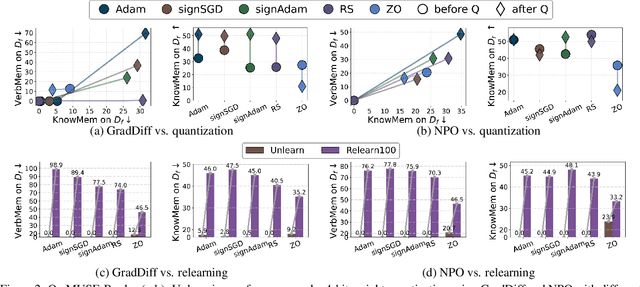

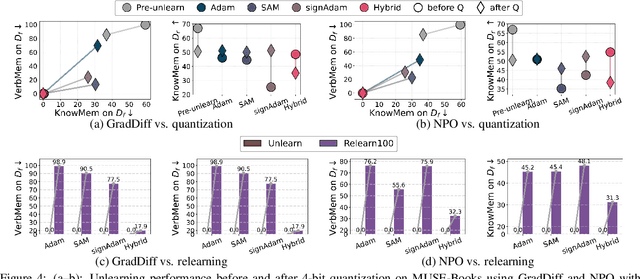
Abstract:Large language model (LLM) unlearning aims to surgically remove the influence of undesired data or knowledge from an existing model while preserving its utility on unrelated tasks. This paradigm has shown promise in addressing privacy and safety concerns. However, recent findings reveal that unlearning effects are often fragile: post-unlearning manipulations such as weight quantization or fine-tuning can quickly neutralize the intended forgetting. Prior efforts to improve robustness primarily reformulate unlearning objectives by explicitly assuming the role of vulnerability sources. In this work, we take a different perspective by investigating the role of the optimizer, independent of unlearning objectives and formulations, in shaping unlearning robustness. We show that the 'grade' of the optimizer, defined by the level of information it exploits, ranging from zeroth-order (gradient-free) to first-order (gradient-based) to second-order (Hessian-based), is tightly linked to the resilience of unlearning. Surprisingly, we find that downgrading the optimizer, such as using zeroth-order methods or compressed-gradient variants (e.g., gradient sign-based optimizers), often leads to stronger robustness. While these optimizers produce noisier and less precise updates, they encourage convergence to harder-to-disturb basins in the loss landscape, thereby resisting post-training perturbations. By connecting zeroth-order methods with randomized smoothing, we further highlight their natural advantage for robust unlearning. Motivated by these insights, we propose a hybrid optimizer that combines first-order and zeroth-order updates, preserving unlearning efficacy while enhancing robustness. Extensive experiments on the MUSE and WMDP benchmarks, across multiple LLM unlearning algorithms, validate that our approach achieves more resilient forgetting without sacrificing unlearning quality.
Reasoning Model Unlearning: Forgetting Traces, Not Just Answers, While Preserving Reasoning Skills
Jun 15, 2025Abstract:Recent advances in large reasoning models (LRMs) have enabled strong chain-of-thought (CoT) generation through test-time computation. While these multi-step reasoning capabilities represent a major milestone in language model performance, they also introduce new safety risks. In this work, we present the first systematic study to revisit the problem of machine unlearning in the context of LRMs. Machine unlearning refers to the process of removing the influence of sensitive, harmful, or undesired data or knowledge from a trained model without full retraining. We show that conventional unlearning algorithms, originally designed for non-reasoning models, are inadequate for LRMs. In particular, even when final answers are successfully erased, sensitive information often persists within the intermediate reasoning steps, i.e., CoT trajectories. To address this challenge, we extend conventional unlearning and propose Reasoning-aware Representation Misdirection for Unlearning ($R^2MU$), a novel method that effectively suppresses sensitive reasoning traces and prevents the generation of associated final answers, while preserving the model's reasoning ability. Our experiments demonstrate that $R^2MU$ significantly reduces sensitive information leakage within reasoning traces and achieves strong performance across both safety and reasoning benchmarks, evaluated on state-of-the-art models such as DeepSeek-R1-Distill-LLaMA-8B and DeepSeek-R1-Distill-Qwen-14B.
BLUR: A Bi-Level Optimization Approach for LLM Unlearning
Jun 09, 2025Abstract:Enabling large language models (LLMs) to unlearn knowledge and capabilities acquired during training has proven vital for ensuring compliance with data regulations and promoting ethical practices in generative AI. Although there are growing interests in developing various unlearning algorithms, it remains unclear how to best formulate the unlearning problem. The most popular formulation uses a weighted sum of forget and retain loss, but it often leads to performance degradation due to the inherent trade-off between forget and retain losses. In this work, we argue that it is important to model the hierarchical structure of the unlearning problem, where the forget problem (which \textit{unlearns} certain knowledge and/or capabilities) takes priority over the retain problem (which preserves model utility). This hierarchical structure naturally leads to a bi-level optimization formulation where the lower-level objective focuses on minimizing the forget loss, while the upper-level objective aims to maintain the model's utility. Based on this new formulation, we propose a novel algorithm, termed Bi-Level UnleaRning (\texttt{BLUR}), which not only possesses strong theoretical guarantees but more importantly, delivers superior performance. In particular, our extensive experiments demonstrate that \texttt{BLUR} consistently outperforms all the state-of-the-art algorithms across various unlearning tasks, models, and metrics. Codes are available at https://github.com/OptimAI-Lab/BLURLLMUnlearning.
EPiC: Towards Lossless Speedup for Reasoning Training through Edge-Preserving CoT Condensation
Jun 04, 2025
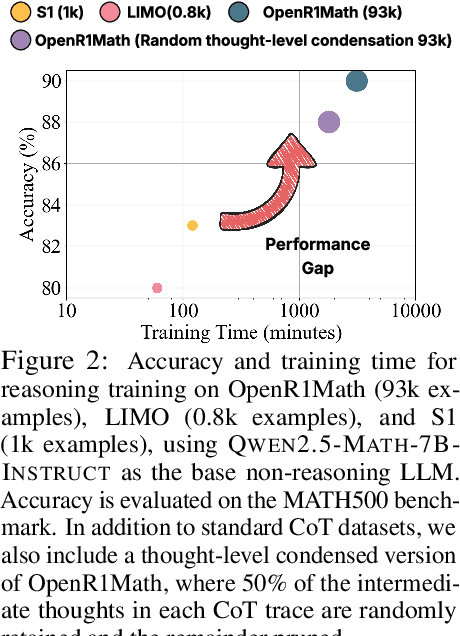

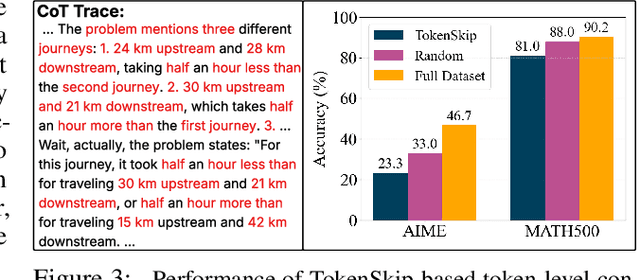
Abstract:Large language models (LLMs) have shown remarkable reasoning capabilities when trained with chain-of-thought (CoT) supervision. However, the long and verbose CoT traces, especially those distilled from large reasoning models (LRMs) such as DeepSeek-R1, significantly increase training costs during the distillation process, where a non-reasoning base model is taught to replicate the reasoning behavior of an LRM. In this work, we study the problem of CoT condensation for resource-efficient reasoning training, aimed at pruning intermediate reasoning steps (i.e., thoughts) in CoT traces, enabling supervised model training on length-reduced CoT data while preserving both answer accuracy and the model's ability to generate coherent reasoning. Our rationale is that CoT traces typically follow a three-stage structure: problem understanding, exploration, and solution convergence. Through empirical analysis, we find that retaining the structure of the reasoning trace, especially the early stage of problem understanding (rich in reflective cues) and the final stage of solution convergence, is sufficient to achieve lossless reasoning supervision. To this end, we propose an Edge-Preserving Condensation method, EPiC, which selectively retains only the initial and final segments of each CoT trace while discarding the middle portion. This design draws an analogy to preserving the "edge" of a reasoning trajectory, capturing both the initial problem framing and the final answer synthesis, to maintain logical continuity. Experiments across multiple model families (Qwen and LLaMA) and benchmarks show that EPiC reduces training time by over 34% while achieving lossless reasoning accuracy on MATH500, comparable to full CoT supervision. To the best of our knowledge, this is the first study to explore thought-level CoT condensation for efficient reasoning model distillation.
Towards LLM Unlearning Resilient to Relearning Attacks: A Sharpness-Aware Minimization Perspective and Beyond
Feb 07, 2025Abstract:The LLM unlearning technique has recently been introduced to comply with data regulations and address the safety and ethical concerns of LLMs by removing the undesired data-model influence. However, state-of-the-art unlearning methods face a critical vulnerability: they are susceptible to ``relearning'' the removed information from a small number of forget data points, known as relearning attacks. In this paper, we systematically investigate how to make unlearned models robust against such attacks. For the first time, we establish a connection between robust unlearning and sharpness-aware minimization (SAM) through a unified robust optimization framework, in an analogy to adversarial training designed to defend against adversarial attacks. Our analysis for SAM reveals that smoothness optimization plays a pivotal role in mitigating relearning attacks. Thus, we further explore diverse smoothing strategies to enhance unlearning robustness. Extensive experiments on benchmark datasets, including WMDP and MUSE, demonstrate that SAM and other smoothness optimization approaches consistently improve the resistance of LLM unlearning to relearning attacks. Notably, smoothness-enhanced unlearning also helps defend against (input-level) jailbreaking attacks, broadening our proposal's impact in robustifying LLM unlearning. Codes are available at https://github.com/OPTML-Group/Unlearn-Smooth.
Forget Vectors at Play: Universal Input Perturbations Driving Machine Unlearning in Image Classification
Dec 21, 2024Abstract:Machine unlearning (MU), which seeks to erase the influence of specific unwanted data from already-trained models, is becoming increasingly vital in model editing, particularly to comply with evolving data regulations like the ``right to be forgotten''. Conventional approaches are predominantly model-based, typically requiring retraining or fine-tuning the model's weights to meet unlearning requirements. In this work, we approach the MU problem from a novel input perturbation-based perspective, where the model weights remain intact throughout the unlearning process. We demonstrate the existence of a proactive input-based unlearning strategy, referred to forget vector, which can be generated as an input-agnostic data perturbation and remains as effective as model-based approximate unlearning approaches. We also explore forget vector arithmetic, whereby multiple class-specific forget vectors are combined through simple operations (e.g., linear combinations) to generate new forget vectors for unseen unlearning tasks, such as forgetting arbitrary subsets across classes. Extensive experiments validate the effectiveness and adaptability of the forget vector, showcasing its competitive performance relative to state-of-the-art model-based methods. Codes are available at https://github.com/Changchangsun/Forget-Vector.
Robust Multi-bit Text Watermark with LLM-based Paraphrasers
Dec 04, 2024Abstract:We propose an imperceptible multi-bit text watermark embedded by paraphrasing with LLMs. We fine-tune a pair of LLM paraphrasers that are designed to behave differently so that their paraphrasing difference reflected in the text semantics can be identified by a trained decoder. To embed our multi-bit watermark, we use two paraphrasers alternatively to encode the pre-defined binary code at the sentence level. Then we use a text classifier as the decoder to decode each bit of the watermark. Through extensive experiments, we show that our watermarks can achieve over 99.99\% detection AUC with small (1.1B) text paraphrasers while keeping the semantic information of the original sentence. More importantly, our pipeline is robust under word substitution and sentence paraphrasing perturbations and generalizes well to out-of-distributional data. We also show the stealthiness of our watermark with LLM-based evaluation. We open-source the code: https://github.com/xiaojunxu/multi-bit-text-watermark.
UOE: Unlearning One Expert Is Enough For Mixture-of-experts LLMS
Nov 27, 2024
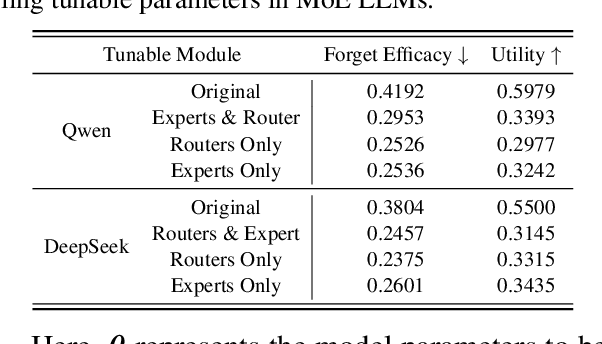


Abstract:Recent advancements in large language model (LLM) unlearning have shown remarkable success in removing unwanted data-model influences while preserving the model's utility for legitimate knowledge. However, despite these strides, sparse Mixture-of-Experts (MoE) LLMs--a key subset of the LLM family--have received little attention and remain largely unexplored in the context of unlearning. As MoE LLMs are celebrated for their exceptional performance and highly efficient inference processes, we ask: How can unlearning be performed effectively and efficiently on MoE LLMs? And will traditional unlearning methods be applicable to MoE architectures? Our pilot study shows that the dynamic routing nature of MoE LLMs introduces unique challenges, leading to substantial utility drops when existing unlearning methods are applied. Specifically, unlearning disrupts the router's expert selection, causing significant selection shift from the most unlearning target-related experts to irrelevant ones. As a result, more experts than necessary are affected, leading to excessive forgetting and loss of control over which knowledge is erased. To address this, we propose a novel single-expert unlearning framework, referred to as UOE, for MoE LLMs. Through expert attribution, unlearning is concentrated on the most actively engaged expert for the specified knowledge. Concurrently, an anchor loss is applied to the router to stabilize the active state of this targeted expert, ensuring focused and controlled unlearning that preserves model utility. The proposed UOE framework is also compatible with various unlearning algorithms. Extensive experiments demonstrate that UOE enhances both forget quality up to 5% and model utility by 35% on MoE LLMs across various benchmarks, LLM architectures, while only unlearning 0.06% of the model parameters.
WAGLE: Strategic Weight Attribution for Effective and Modular Unlearning in Large Language Models
Oct 23, 2024Abstract:The need for effective unlearning mechanisms in large language models (LLMs) is increasingly urgent, driven by the necessity to adhere to data regulations and foster ethical generative AI practices. Despite growing interest of LLM unlearning, much of the existing research has focused on varied unlearning method designs to boost effectiveness and efficiency. However, the inherent relationship between model weights and LLM unlearning has not been extensively examined. In this paper, we systematically explore how model weights interact with unlearning processes in LLMs and we design the weight attribution-guided LLM unlearning method, WAGLE, which unveils the interconnections between 'influence' of weights and 'influence' of data to forget and retain in LLM generation. By strategically guiding the LLM unlearning across different types of unlearning methods and tasks, WAGLE can erase the undesired content, while maintaining the performance of the original tasks. We refer to the weight attribution-guided LLM unlearning method as WAGLE, which unveils the interconnections between 'influence' of weights and 'influence' of data to forget and retain in LLM generation. Our extensive experiments show that WAGLE boosts unlearning performance across a range of LLM unlearning methods such as gradient difference and (negative) preference optimization, applications such as fictitious unlearning, malicious use prevention, and copyrighted information removal, and models including Zephyr-7b-beta and Llama2-7b. To the best of our knowledge, our work offers the first principled method for attributing and pinpointing the influential weights in enhancing LLM unlearning. It stands in contrast to previous methods that lack weight attribution and simpler weight attribution techniques.
Simplicity Prevails: Rethinking Negative Preference Optimization for LLM Unlearning
Oct 09, 2024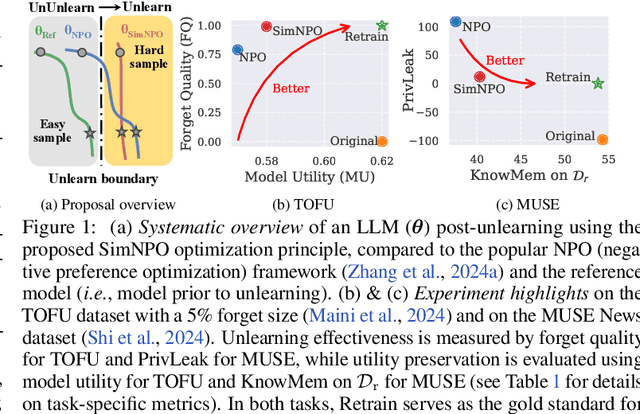

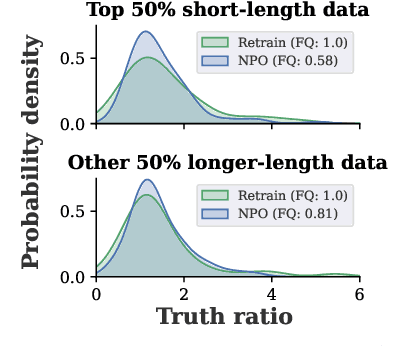
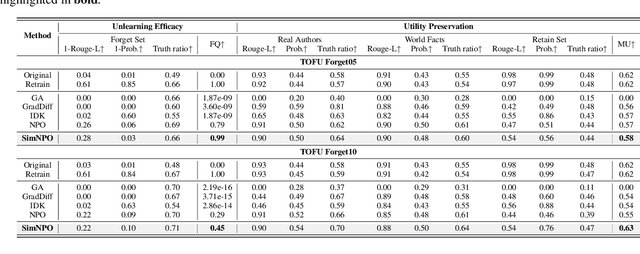
Abstract:In this work, we address the problem of large language model (LLM) unlearning, aiming to remove unwanted data influences and associated model capabilities (e.g., copyrighted data or harmful content generation) while preserving essential model utilities, without the need for retraining from scratch. Despite the growing need for LLM unlearning, a principled optimization framework remains lacking. To this end, we revisit the state-of-the-art approach, negative preference optimization (NPO), and identify the issue of reference model bias, which could undermine NPO's effectiveness, particularly when unlearning forget data of varying difficulty. Given that, we propose a simple yet effective unlearning optimization framework, called SimNPO, showing that 'simplicity' in removing the reliance on a reference model (through the lens of simple preference optimization) benefits unlearning. We also provide deeper insights into SimNPO's advantages, supported by analysis using mixtures of Markov chains. Furthermore, we present extensive experiments validating SimNPO's superiority over existing unlearning baselines in benchmarks like TOFU and MUSE, and robustness against relearning attacks. Codes are available at https://github.com/OPTML-Group/Unlearn-Simple.
 Add to Chrome
Add to Chrome Add to Firefox
Add to Firefox Add to Edge
Add to Edge